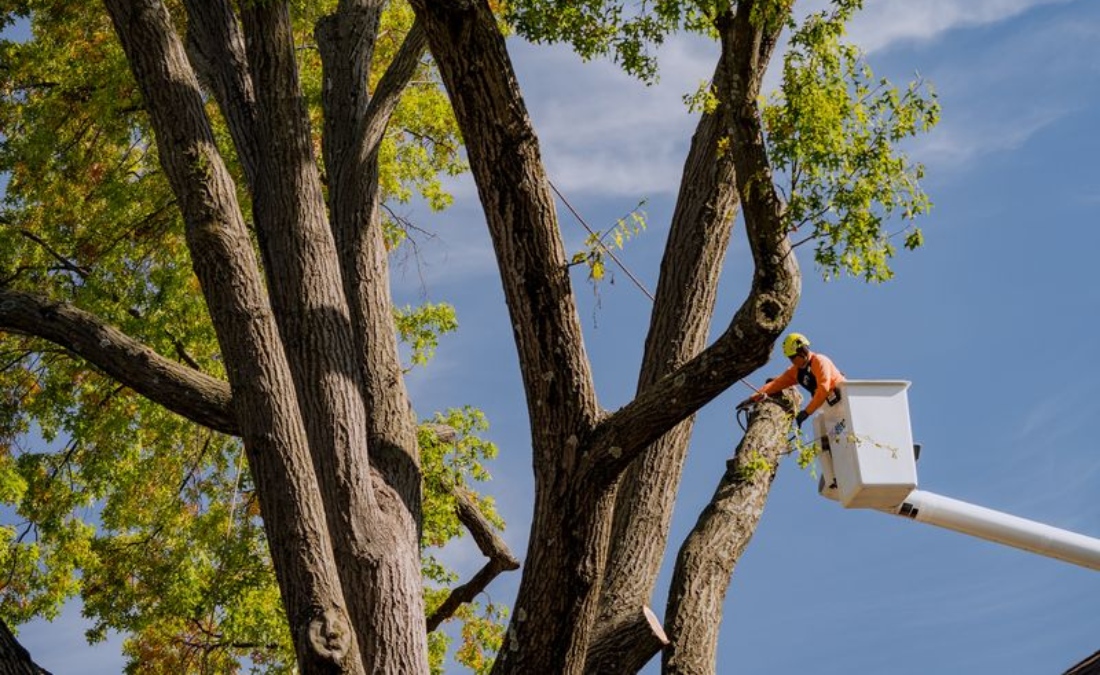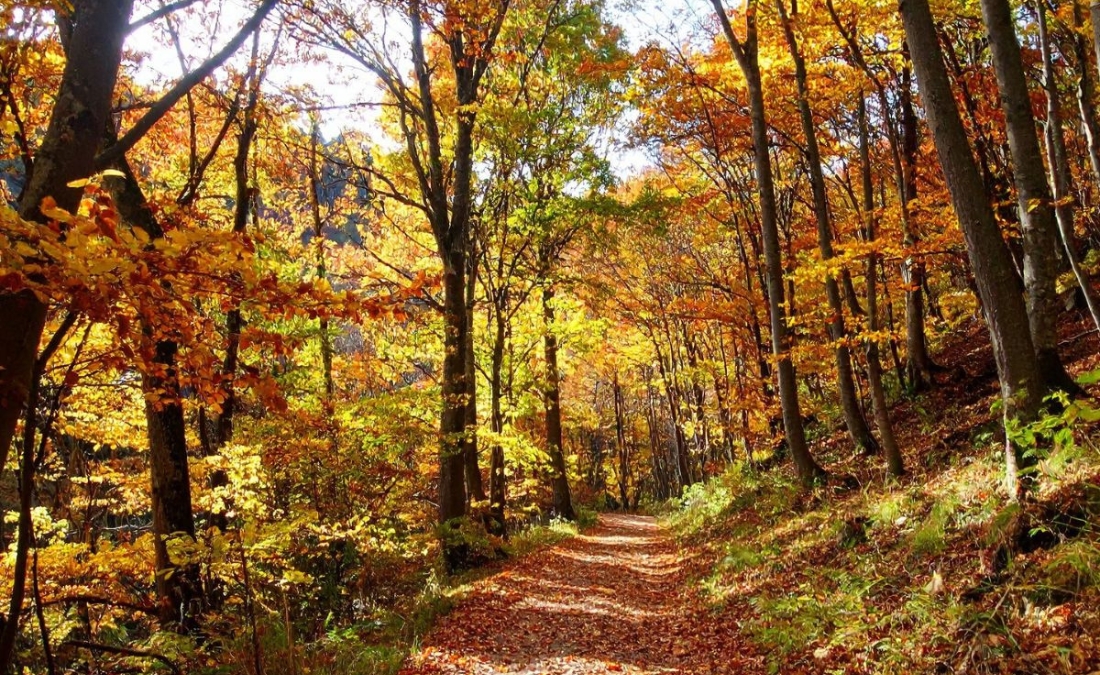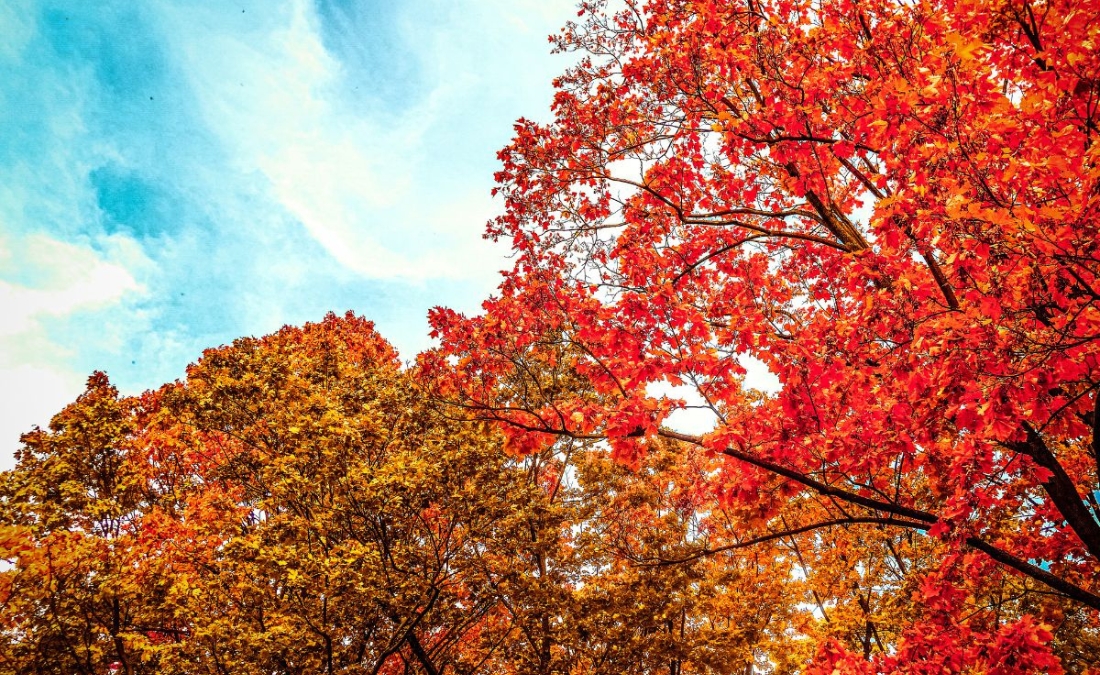Winter Oak Pruning in the Quad Cities: The Right Time for Healthy Resilient Trees
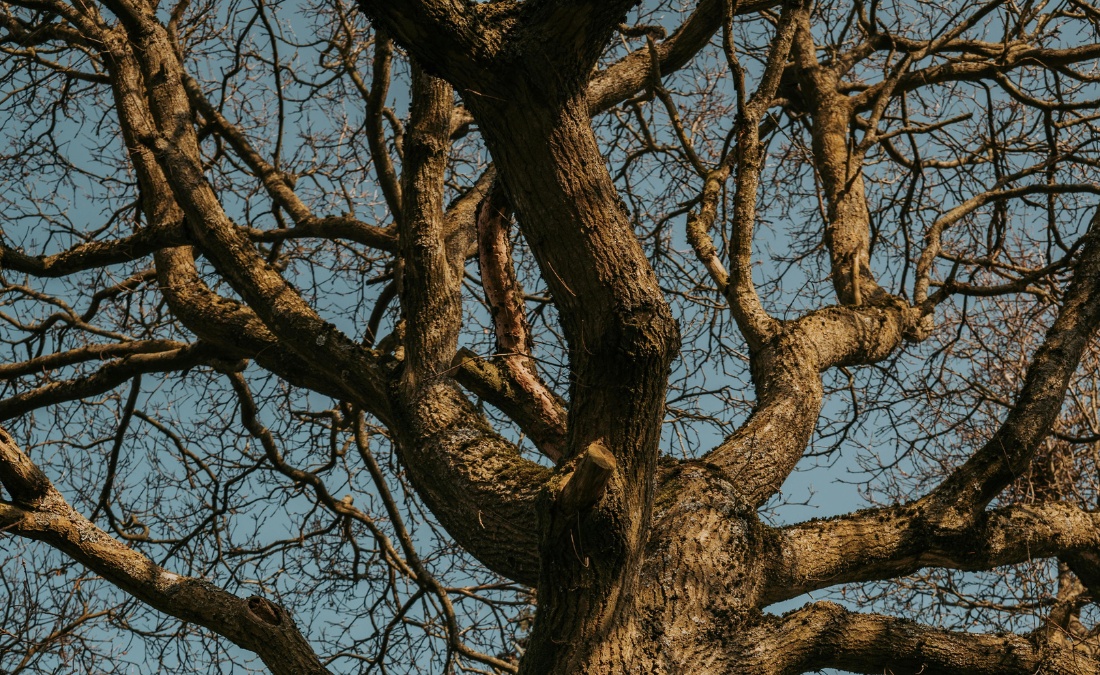
Winter is the only safe season to prune oaks in the Quad Cities. Learn why proper timing protects your trees and keeps them healthy year after year.
If you have oak trees in McClellan Heights, Hamburg Historic District, or anywhere across the Quad Cities, you face a narrow window for safe pruning. Prune at the wrong time, and you risk exposing your tree to oak wilt, a fatal fungal disease that can kill a mature red oak in as little as three weeks.
December through February is the only truly safe window for oak pruning in the Quad Cities. And with limited working days due to weather conditions and high demand following this summer’s storms, now is the best time to schedule your winter oak pruning before calendar slots fill completely.
Key Takeaways
- December through February is the only safe pruning window for oak trees because the sap-feeding beetles that spread deadly oak wilt are inactive during winter months when trees are dormant.
- Oak wilt kills red oaks in 3-4 weeks once infected, making prevention through proper timing your best defense against losing valuable mature trees in historic neighborhoods.
- Book your winter pruning in October or November because weather-dependent working days are limited and demand is high following summer storm damage that created a backlog of trees needing winter care.
- Trees damaged in July 2025 storms couldn’t be safely pruned during growing season and now compete for the same limited winter slots as routine maintenance, creating unprecedented booking pressure.
- Only ISA Certified Arborists should prune your oaks because proper technique protects the tree’s natural defense mechanisms and prevents disease entry points that compromise long-term health.
- Professional winter pruning protects your property’s value by preventing oak wilt and costly tree loss.
When Can You Safely Prune Oak Trees in Iowa and Illinois?
The only safe time to prune oak trees in Iowa and Illinois is December through February. Based on the life cycle of the beetles that spread the disease and the activity patterns of the fungus itself, this narrow window is the best opportunity to protect against the deadly threat of oak wilt.
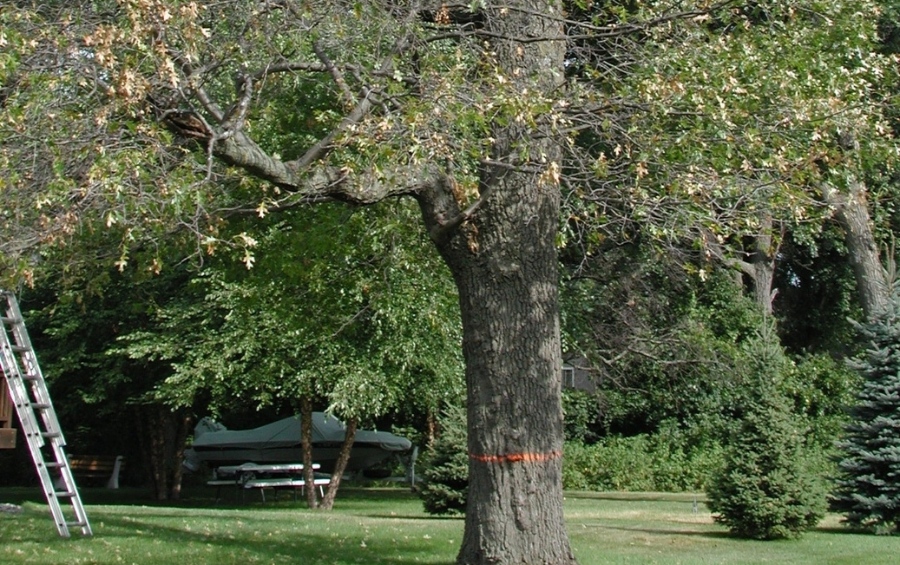
Oak wilt symptoms start at the top of the tree and progress rapidly downward. Early detection by an ISA Certified Arborist can help protect nearby healthy oaks.
Why Is Winter the Safest Time to Prune Oak Trees?
Winter is the safest time to prune oak trees because the beetles and fungus that spread oak wilt are completely inactive during cold weather. From April through October, sap-feeding beetles are abundant across the Quad Cities. They’re drawn to the sweet-smelling fungal mats that form beneath the bark of infected oaks. When they feed, fungal spores stick to their bodies and are easily carried to healthy trees.
If you prune during this active season, fresh cuts release sap that attracts these beetles. A single contaminated beetle can introduce oak wilt into your tree, leading to rapid decline. Red oaks such as northern red, pin, and black oaks often die within weeks, while white oaks may take years but eventually succumb as well.
The Iowa Department of Natural Resources recommends waiting until after October 15 to begin pruning oaks, with the safest pruning window running through March 1. However, at Arbor Masters, we focus on the core December-February period because it provides the greatest margin of safety as both the beginning and end of the season can see unseasonably warm weather that brings beetles out early or keeps them active late.
“If you have oak or elm trees, winter is your only safe window to prune them. From April through summer, sap-feeding beetles can spread oak wilt and Dutch elm disease through fresh pruning cuts; both can kill a mature tree in a single season. December through February is when those beetles are inactive, making it the perfect time to protect your trees. Booking your pruning now ensures we can get the work scheduled before the window closes.” – Stephen Carlson, Director of Sales at Arbor Masters
What About Emergency Oak Pruning Outside the Safe Window?
Emergency oak pruning outside the safe window becomes necessary when storm damage, hanging branches over structures, or other immediate safety hazards threaten tree health and property safety.
In the instances when emergency pruning is necessary during the growing season, professional arborists take specific protective measures to minimize oak wilt risk by creating a temporary barrier using latex house paint that prevents beetles from contacting the wound while the tree begins its natural healing process.
However, this emergency protocol requires immediate response and proper technique that only trained professionals should attempt. And it’s important to note: even with proper precautions, growing season pruning carries inherent risk.
Winter pruning eliminates the risk entirely by removing the disease transmission pathway rather than merely blocking it.
The 2025-2026 Winter Pruning Season Faces Unprecedented Demand
This winter’s oak pruning season faces unique pressure. If you’re researching when to schedule your oak pruning, it’s important to understand why booking early matters more this year than in typical seasons.
How July 2025 Storm Damage Created a Backlog of Oak Pruning Work
On July 11, 2025, severe storms brought 72 mph winds, tornadoes, and widespread tree damage across Davenport and the Quad Cities. The damage was significant, with numerous large tree limbs down and entire trees damaged or destroyed across a 7.2 mile stretch within Scott County.
Because pruning in mid-summer would have exposed trees to infection, ISA Certified Arborists advised homeowners to wait until the safe winter window. That meant thousands of storm-damaged oaks had to remain untouched for months, with corrective pruning postponed until temperatures dropped and beetles became inactive.
Now, as winter approaches, those deferred storm repairs compete with routine seasonal pruning across neighborhoods like McClellan Heights, Hamburg Historic District, and Vander Veer Park. The result is an unprecedented demand for a limited number of winter pruning days.
Why Weather Cuts the Quad Cities’ Winter Tree Work Window Short
Winter weather in the Quad Cities dramatically restricts when tree work can safely happen, meaning that the December-February window isn’t 90 continuous working days. There are numerous factors at play that determine what work and how much of it we can get done in a single winter season:
- Extreme cold stresses trees and makes them more vulnerable to winter injury, limiting work to days with moderate temperatures
- Ice storms, heavy snow, and frozen ground prevent equipment access and create dangerous working conditions
- High wind speeds make climbing unsafe and increase risk to both crews and property
- Short daylight hours compress working time, especially in December and January
In a typical winter, Arbor Masters has approximately 40-50 actual working days spread across the three-month window. This year, the combination of July storm damage backlog and normal seasonal demand means those limited days will fill quickly.
That’s why our ISA Certified Arborists are scheduling consultations now to ensure both storm-damaged and routine maintenance oaks receive proper care during the safest possible timeframe.
Book Oak Pruning in October or November for the Best Results
October and November is the best time to book oak pruning because it ensures you secure a spot on our winter calendar before the rush. We can schedule your consultation, assess your trees, and plan the work for optimal timing within the safe window.
Wait until December, however, and you’re not only competing with other homeowners who chose to wait, but also those whose storm-damaged oaks have been on hold since July. You might get scheduled for late February when weather is less predictable, or worse, miss the safe window entirely and face another year of waiting.

Frequently Asked Questions About Oak Pruning in the Quad Cities
Will my oak tree survive if it was accidentally pruned during beetle season?
Not every oak pruned during the active beetle season becomes infected with oak wilt, but the risk is high enough that professionals strongly recommend avoiding any pruning between April and October. If your oak was recently pruned during that period, watch for early symptoms such as wilting or browning leaves that progress from the top of the canopy downward.
Even if infection isn’t immediately visible, contact an ISA Certified Arborist to evaluate the tree and surrounding oaks. They can assess the likelihood of exposure and, if needed, take preventive measures to help protect nearby healthy trees.
Can I tell the difference between oak wilt and drought stress?
Both oak wilt and drought stress cause wilting leaves, but the patterns differ. Drought stress typically affects the entire tree uniformly with leaves drooping but often remaining green initially. Oak wilt starts at the top of the tree and rapidly progresses downward, with leaves turning brown from the tips and edges inward while the center may stay green initially. Oak wilt progression is also much faster: red oaks can go from first symptoms to death in 3-4 weeks, while drought stress develops more gradually over an entire season.
Should I remove a healthy oak near one that died from oak wilt?
Not necessarily, but the healthy oak may be at risk through root grafts (interconnected root systems) if the trees are close together. Oaks of the same species growing within 50 feet of each other often have interconnected root systems that can transmit oak wilt underground, completely independent of beetle transmission. An ISA Certified Arborist should assess the situation and may recommend preventive fungicide injections for valuable healthy oaks near confirmed oak wilt cases, or root barrier installation if removal isn’t desired.
How soon after winter pruning will I see new growth on my oak?
You won’t see any new growth immediately because oaks pruned in December through February are dormant. New growth begins in spring, typically April or May in the Quad Cities, when temperatures warm and the tree breaks dormancy. The first growing season after proper winter pruning, you may notice more vigorous growth and better branch structure as the tree redirects energy from removed deadwood or crossing branches into healthy, well-positioned limbs.

Every Arbor Masters oak pruning project begins with a comprehensive safety briefing and work plan review led by our ISA Certified Arborists.
Schedule Your Winter Oak Pruning in the Quad Cities with Arbor Masters
Your December-February window for safe oak pruning is approaching. With unprecedented demand following July’s storm damage and limited weather-dependent working days, the time to book your winter pruning is now.
Don’t risk another year of oak wilt exposure or miss the winter window by waiting too long. Call us at 563-355-7508 to schedule your consultation, or request an estimate online today.

Get the latest local news, tree care tips, special offers, and company updates directly to your inbox! It's easy to subscribe and there's no spam - we promise.
"*" indicates required fields

